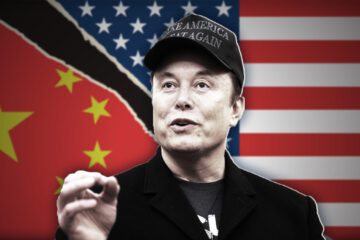The Federal Reserve will hold its benchmark rate steady at the highest level in more than two decades when its wraps up its latest policy meeting Wednesday, but investors are far more focused on the central bank’s view of how and for how long inflation will linger in the world’s biggest economy.
The so-called ‘last mile’ of the Fed’s inflation fight, and its effort to return price pressures to its preferred target of 2%, has proved incrementally difficult over the past few months. Following the most aggressive series of rate hikes in a least a generation, which included a five-percentage-point increase in the Fed’s benchmark lending rate in less than two years, inflation slowed from a four-decade peak of 9.1% in summer 2022 to just above 3% in last autumn.
Since then, however, a host of economic data — from job gains to wage increases to broader consumer spending growth — has kept inflation elevated and stalled the Fed’s progress in meeting its 2% inflation objective.
That’s led the Fed, which had to admit to an embarrassing error in deeming inflation “transitory” in winter 2021 before pivoting to its strategy of aggressive rate hikes, to pivot yet again in seeking more time, and more convincing data, in order to find the confidence to being cutting rates again.
“Right now, given the strength of the labor market and progress on inflation so far, it’s appropriate to allow restrictive policy further time to work and let the data and the evolving outlook guide us,” Fed Chairman Jerome Powell told an economic event in Washington on April 16.
“If higher inflation does persist, we can maintain the current level of restriction for as long as needed,” he added. “At the same time, we have significant space to ease should the labor market unexpectedly weaken.”
Fed Chairman Jerome Powell wants to leave his rate options open, but persistently high inflation is leaving him with few alternatives beyond “higher for longer.'”
Market reaction to that pivot has been visceral, but for the most part orderly: Benchmark 2-year-note yields, the most-sensitive to interest-rate forecasts, have risen more than a full percentage point since early January and are now trading firmly north of 5%.
Bets on interest-rate cuts are fading fast
Bets on a series of Fed rate cuts this year, meanwhile, have disappeared, with markets now committing to only one rate reduction — likely in December — while also pricing in a modest risk of another rate increase.
The stock market, meanwhile, has given back more than half its year-to-date gains since late March, and recorded its first monthly decline since last September, on the back of the hot inflation data and the Fed’s likely reaction to it.
That leaves Powell, who rightly or wrongly bore the brunt of the market’s scorn for his “transitory” stance, with little room to maneuver as he prepares to speak to the media following the Fed’s interest-rate statement Wednesday afternoon.
Related: Fed inflation gauge holds steady in March, boosting stocks on rate cut bets
“We’re expecting the Fed to walk this very narrow line between hawkishness and trying not to completely tank the stock market,” said Bryce Doty, senior portfolio manager at Sit Investment Associates in Minneapolis. “Because if they’re too hawkish, that means they’re going to keep rates so high that it destroys the economy.”
“Powell has to voice concerns that inflation is not approaching 2% or stabilizing around 2% like he wants it to,” he added. “However, if he comes off too tough, fears of recession will reemerge and create a lot of unwelcome uncertainty.”
The U.S.: a star-spangled economy
So far, the economy has been able to weather the Fed’s restrictive rate stance, but cracks in the otherwise solid facade are most definitely appearing.
The Commerce Department’s first quarter GDP estimate showed growth slowing to 1.6%, well shy of Wall Street forecasts, and the Conference Board’s most-recent reading of consumer confidence showed sentiment falling to the lowest level in nearly three years.
Further weakness over the coming months, particularly in the surprisingly resilient job market, would likely trigger a Fed rethink on rates, even if inflation hovers near its current pace of around 3%, through either a “high for longer” stance or the reintroduction of rate hike risk.
Related: U.S. growth slowdown, with inflation spike, raises early stagflation risks
“With inflation data continuing to be surprisingly hot for the past quarter, the narrative that these surprises are all attributable to one-offs in individual components is becoming harder to sustain,” said Vanguard economists Joe Davis and Josh Hirt.
“Time will tell but the data suggest that what we call a ‘deferred landing’ is more likely than the long anticipated ‘soft landing,'” they added. “Along with our forecast for core inflation pressures to remain elevated as supply tailwinds fade, we expect this to keep the Fed cautious on cutting rates in 2024.”
Fed’s balance sheet is in focus
One tactic the Fed could deploy — at least to enable markets to filter out some of the more restrictive elements of higher rates while buying enough time to gauge inflation pressure and keep the federal-funds rate unchanged — would be to slow the pace of sales from its $7.4 trillion balance sheet.
At present, the Fed is putting around $60 billion in Treasury bonds back into the market each move. This, along with bigger auction sizes linked to the Treasury’s borrowing mandate, has partly fueled the recent rise in short-term yields.
Halving that pace to around $30 billion, some argue, would ease market rates without the central bank having to tweak the benchmark federal-funds level, which currently sits between 5.25% and 5.5%.
Related: No landing, no Fed rate cuts: the markets’ new bet on 2024
However, Jeff Klingelhofer, co-head of investments and portfolio manager at Thornburg Investment Management, isn’t buying it.
“I’m notably more hawkish here, and out of consensus [but] I see no real benefit to shifting balance-sheet runoff at this point,” he said. “It’s clear policy isn’t as restrictive as the Fed believes.”
There’s certainly evidence to suggest that: The Atlanta Fed’s GDPNow forecasting tool suggests the economy is growing at a searing 3.9% pace, and even its final reading for the first quarter is around 1.1 percentage points higher than the Commerce Department’s first estimate of 1.6%.
U.S. economic ‘regime shift’ possible?
The Labor Department’s employment-cost index came in well ahead of analysts’ forecasts over the first quarter, suggesting solid job-market momentum into the spring. And companies ranging from Coca-Cola (KO) to Procter & Gamble (PG) to McDonald’s (MCD) have said they’re able to comfortably pass on price increases to their wide swaths of customers.
That’s led Scott Helfstein, who heads investment strategy at ETF trading group Global X, to imagine what he calls a “regime shift” for the world’s biggest economy that will leave the Fed on hold until at least year-end.
More Economic Analysis:
Watch out for 8% mortgage ratesHot inflation report batters stocks; here’s what happens nextInflation report will disappoint markets (and the Fed)
“The low growth, low inflation, and low real rate financial repression of the past 20 years may be coming to an end,” he said. “The economy could grow and innovation can march ahead with 5.5% fed funds.”
“The late ’70s, mid-’80s, and late ’90s averaged interest rates above 4.5% (and) real rates were similar to the current 2%,” he added. “The markets and growth equities did quite well in those periods.”
Related: Veteran fund manager picks favorite stocks for 2024


